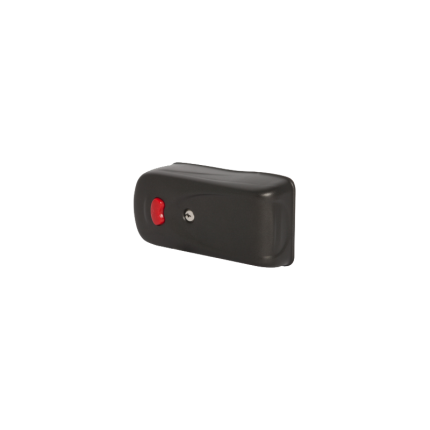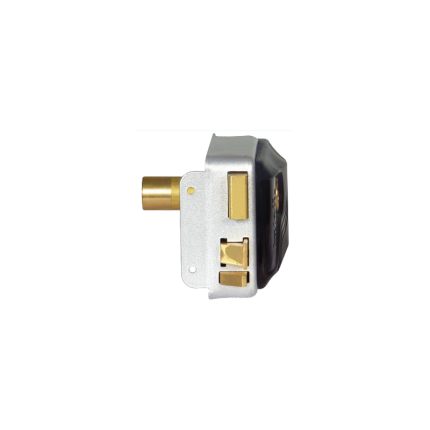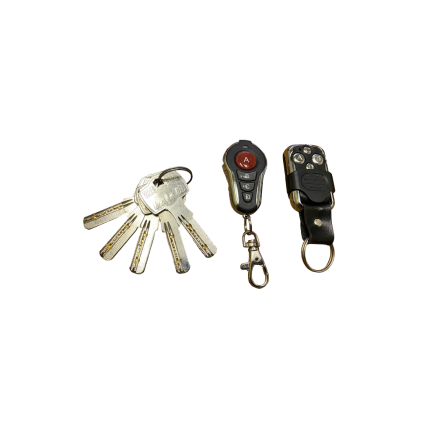electric
Electric Rim Lock RGEL1093
Ship or pick up from our office.
Electric Rim Lock RGEL1093
*Capacity: 2000 Kg *DC 12 V *15 W (5 x release keys are included) This is a heavy-duty electric lock that holds the gate closed. The lock latches strongly to the hook and prevents the gate to be opened by wind or intruders. It will release automatically before the arms start moving. There are five keys in the package for unlocking during power outages. Free installation session is provided in our office. Watch previous project videos on our YouTube channel.- Heavy Duty
- High Security
- Quiet Operation
- Compatible with single and double swing gates
- Keeps full privacy gates in place in windy weather
The RGEL1093 is a heavy-duty electric rim lock designed for gates. It latches securely to prevent opening by wind or intruders and releases automatically before gate movement. The lock includes five keys for manual unlocking during power outages.
Here's a more detailed breakdown:
-
Function:The RGEL1093 is a surface-mounted lock that provides a secure latch for gates.
-
Security:It is designed to withstand strong winds and prevent unauthorized entry.
-
Automatic Release:The lock releases automatically as the gate's opening mechanism starts to move.
-
Power Outages:The inclusion of five keys allows for manual operation when power is unavailable.
-
Installation:It's a rim lock, meaning it's mounted on the surface of the gate, rather than being mortise-set into the edge.
-
Typical Use:Electric rim locks are often used in conjunction with access control systems (like intercoms or keypads) for residential and commercial applications.
Pedestrian gate electric lock
Ship or pick up from our office.
Pedestrian gate electric lock
*DC12 V A pedestrian gate electric lock is a device that uses electrical power to secure a walk-through gate, offering enhanced security and convenience compared to traditional manual locks. These locks are commonly used in residential, commercial, and community settings, often integrated with access control systems. Here's a breakdown of what they are and how they work: How they work:- Electronic Control: The locking mechanism is controlled electronically. This allows it to be locked and unlocked automatically, typically triggered by an access control system.
- Access Control Integration: They can be linked to various access control devices, such as:
- Keypads: Users enter a code to unlock the gate.
- Remote controls: Wireless remotes allow for convenient opening from a distance.
- Intercoms: Visitors can communicate with occupants, who can then grant access.
- Key fobs/Card readers: Users can simply tap or swipe a fob/card to unlock.
- Push buttons: For easy exit from the inside.
- Telephone entry systems: Allowing access via phone.
- Types of Electric Locks:
- Electromechanical Locks: These use an electric impulse to trigger a mechanical latch or bolt to engage or disengage. They are known for their strength and durability, suitable for both indoor and outdoor use.
- Electromagnetic Locks (Maglocks): These consist of an electromagnet mounted on the gate frame and a strike plate on the gate itself. When power is applied, the electromagnet creates a strong magnetic force that holds the gate closed. To unlock, the power to the magnet is simply cut. They offer a high holding force and have no moving parts to wear out.
- Enhanced Security: They provide a higher level of security than manual locks, preventing forced entry and ensuring the gate remains closed, especially in high-wind conditions.
- Automatic Locking/Unlocking: Many models automatically lock when the gate closes and unlock when activated, eliminating the need for manual locking.
- Convenience: Remote operation, keypads, and other access control options make entry and exit much more convenient.
- Versatile Applications: Suitable for a variety of pedestrian gate types (wood, steel, vinyl, etc.) and environments, including driveways, pool areas, playgrounds, and commercial perimeters.
- Fail-Secure vs. Fail-Safe:
- Fail-Secure: The lock remains locked when power is lost. This is common for high-security applications where maintaining security during a power outage is crucial.
- Fail-Safe: The lock unlocks when power is lost. This is often used in safety applications where immediate access is needed during emergencies or power failures.
- Battery Backup: Many systems include a battery backup to ensure continued operation during power outages.
- Manual Override: Most electric locks come with a key for manual release, providing a backup in case of power failure or system malfunction.
- Integration: They can be easily integrated with existing gate openers, timers, and other smart home or security systems.
Pedestrian gate electric lock with remote control
Ship or pick up from our office.
Pedestrian gate electric lock with remote control
* Two remote controls included *DC 12 V pedestrian gate electric lock with a remote control is a security system that allows you to lock and unlock a walk-through gate using an electrical mechanism, typically activated by a remote control. This provides convenience and enhanced security, as you don't need a physical key to open the gate. Here's a breakdown of what it entails: How it Works:- Electric Lock Mechanism: Instead of a traditional manual deadbolt or latch, an electric lock uses an electrical impulse to control a bolt or latch. This impulse can come from a control board connected to various access control devices.
- Remote Control Activation: A key component is the remote control, which sends a wireless signal (radio frequency) to a receiver connected to the lock's control system. When the signal is received and recognized, the lock is instructed to engage (lock) or disengage (unlock).
- Integration with Gate Systems: These locks are often integrated with automatic gate openers or access control systems. When the gate closes, the lock can automatically engage, and when a remote signal is given, it disengages to allow the gate to open.
- Power Source: Electric locks require a power source, typically low voltage (e.g., 12V DC). Many systems include a battery backup to ensure continued operation during power outages.
- Solenoid Locks: These use an electromagnet to extend or retract a bolt, securing or releasing the gate.
- Electromagnetic Locks (Mag Locks): These consist of an electromagnet mounted on the gate frame and a metal strike plate on the gate itself. When power is applied, the electromagnet creates a powerful magnetic force that holds the gate shut. Removing power releases the lock.
- Electric Strikes: These replace the standard strike plate on the gate frame. They contain a solenoid that, when activated, pivots or retracts to release the gate's latch. They are often combined with a traditional keyed doorknob or lever.
- Remote Operation: The primary benefit, allowing you to open or close the gate from a distance.
- Automatic Operation: Many models automatically lock when the gate closes, improving security.
- Fail-Safe vs. Fail-Secure:
- Fail-Secure: The lock remains locked when power is lost. This is common for high-security applications where you want the gate to stay secure even during a power outage.
- Fail-Safe: The lock unlocks when power is lost. This might be preferred for safety reasons, ensuring an exit path in an emergency.
- Holding Force: This indicates the strength of the lock in resisting forced entry, measured in pounds (lbs).
- Compatibility: Ensure the electric lock is compatible with your specific gate type (wood, metal, swing, etc.) and any existing or planned access control systems (keypads, intercoms, smart home systems).
- Manual Override: Many electric locks include a manual release key or mechanism for use in case of power failure or remote control malfunction.
- Durability and Weather Resistance: Given that they are outdoors, look for locks built with durable, weather-resistant materials.
- Integration with Other Access Control: Beyond remote controls, these locks can often be integrated with:
- Keypads (for code entry)
- Intercom systems (audio/video communication and remote release)
- Smartphone apps (for remote monitoring and control)
- Biometric readers (fingerprint, face scan)













